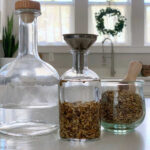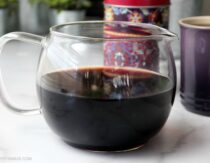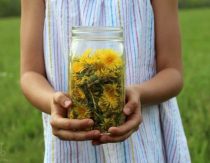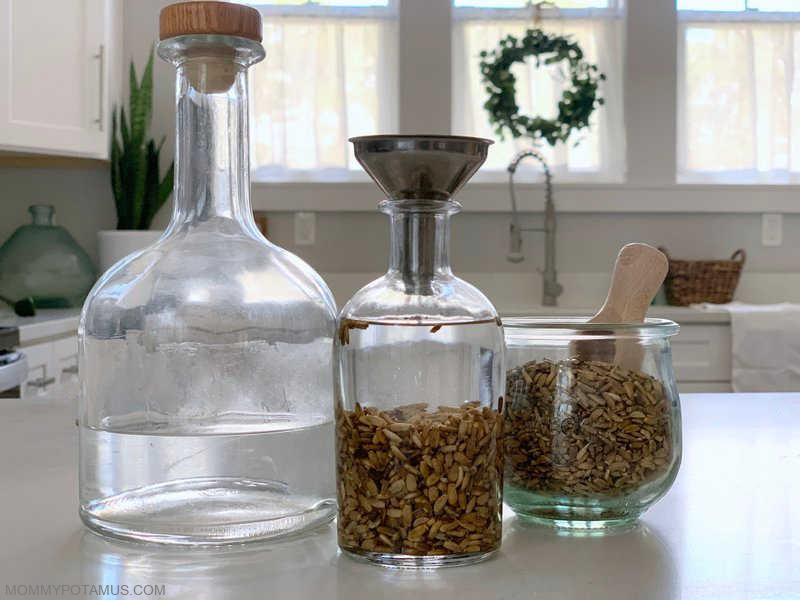
Does your liver need a little extra love? Or maybe you’re wanting to support skin clarity, hormone balance, and strong digestion? Milk thistle has a long history of traditional use for all of that and more.
In this article we’ll dive into the benefits of this powerful yet safe herb, how to use it . . . and how not to!
As always, I want to mention that none of these statements have been evaluated by the FDA, this article is not medical advice, and it is not meant to diagnose or treat any condition. Please talk with your healthcare provider about any herbs or dietary supplements you are considering.
Now that we’ve got that out of the way, let’s dive in!
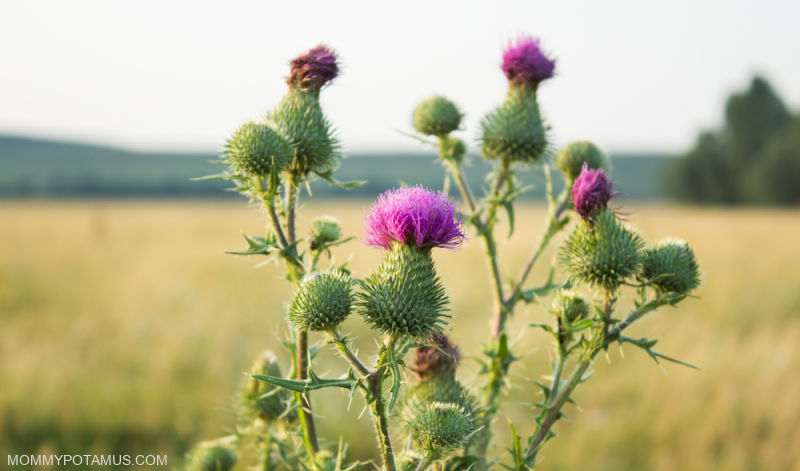
What is milk thistle? ^
Sometimes known as holy thistle, milk thistle (Silybum marianum) can be easily recognized by its spiky purple flowers and lettuce-like leaves.
Native to the Mediterranean and now naturalized in Central Europe, North and South America, and Southern Australia, this member of the sunflower family (Asteraceae) produces a milky white sap when its stems are crushed. That’s part of how it got its name – and the fact that it’s traditionally used to support breast milk production probably played a role, too.
It’s also been used as a potent yet gentle liver tonic since at least the 1st century, when Pliny the Elder wrote that it was “excellent for carrying off bile.” (1) Current research is more focused on this aspect of its benefits.
The main therapeutic component is silymarin, which is group of flavonoids that includes silybin A, silybin B, isosilybin A, isosilybin B, silydianin, silychristin A and B, and silibinin.
It’s primarily found in the seeds, which just so happen to have a nutty, salty, slightly sweet flavor that makes them perfect for grinding and incorporating into smoothies, oatmeal, granola and more. It also works well in savory dishes, which is why I used it to create this “Love Your Liver” Milk Thistle Seasoning Blend.
Milk thistle is also very effective when used in capsule form, which is very simple to incorporate into a daily routine.
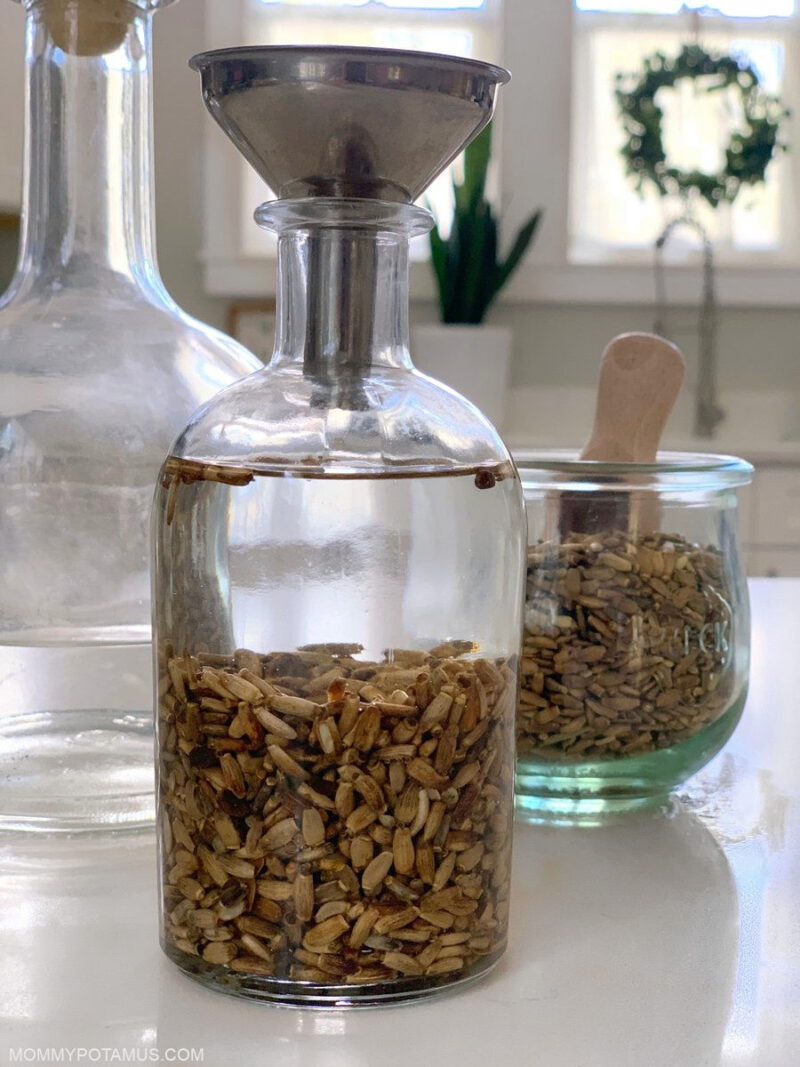
8 Health Benefits of Milk Thistle ^
Milk thistle is considered helpful for:
- Liver Health
- Stress Support & Hormonal Balance
- Skin Clarity for Teens & Adults
- Antioxidant Support
- Breast Milk Production
- Possibly Encouraging Healthy Cholesterol Levels
- Immune & Digestive Support
Let’s take a deeper dive into those benefits:
1. Liver Health & Detox Support
Anytime the liver has extra detoxification work to do, think milk thistle!” – Herbal Medicine for Beginners (2)
With an increasing number of “contaminants of emerging concern” in our water, VOCs in our environment, and other sources of toxic exposure, the demand on our internal detoxification systems is higher than ever before in history.
Milk thistle is an excellent way to give a little extra love to our liver, which is involved in over 500 vital functions including the breakdown of toxins so that they can be safely flushed out of the body. (3)
According to Katja Swift and Ryn Midura, authors of Herbal Medicine for Beginners, milk thistle supports liver health in three distinct ways:
- Providing “nourishment specifically for liver tissue”
- Reducing oxidative stress that can damage liver cells
- Supporting the body’s natural repair mechanisms for repairing already damaged tissue
A substantial amount of research supports these conclusions. (4)
2. Stress Support & Hormonal Balance
Milk thistle is an important herb for people who are chronically stressed, sleep deprived, and overworked, whose high levels of adrenaline and cortisol put an added load on the liver.” – Herbal Medicine for Beginners (2)
One of the liver’s major jobs is to break down and eliminate excess sex hormones (estrogen, progesterone, and testosterone) plus hormones made by the adrenal glands and thyroid.
If the liver has a lot to handle due to overall body burden, a big surge of cortisol due to stress, or some other reason, it can result in suboptimal clearance of hormones.
By helping it function at its best, milk thistle helps the body maintain balanced hormone levels.
3. Skin Clarity For Teens & Adults
Since we just talked about balancing hormones, this is probably a good time to talk about how milk thistle can support clear skin. The liver often handles more than usual during periods of hormonal transition (puberty, perimenopause, and menopause).
Often, this “extra load on the liver can show up on the skin” in the form of blemishes. (2) Milk thistle may help by offering extra support during these seasons. Some research suggests it may help skin stay youthful looking, too! (5)
4. Antioxidant Support
Our bodies break down toxins via oxidation – a process that transforms them into water-soluble compounds that can be flushed out of the body. Oxidation produces free radicals, which can damage tissues and accelerate aging unless they are neutralized by antioxidants.
Milk thistle provides antioxidant support in two ways by:
- Directly supplying the body with silymarin, which is a potent antioxidant
- Serving as a bioactivator of the Nrf2 pathway, which encourages the production of the body’s master antioxidant: glutathione (6) (7)
5. Breast Milk Production
As the name implies, milk thistle promotes milk secretion and is perfectly safe for use by breastfeeding mothers.” (4)
Milk thistle has traditionally been used as a galactogogue, or herb that supports milk production, and modern research seems to support this approach. (8)
6. May Support Healthy Cholesterol Levels
Only about 20% of the cholesterol in our bodies is from food – the rest is made by our liver and gut. (9)
Once made, our bodies use cholesterol to make vitamin D, hormones, and enzymes needed for digestion.
Of course, it is possible to get too much of a good thing, which is why our liver is also – you guessed it – responsible for breaking down used cholesterol so that it doesn’t build up in our system.
By supporting liver function in a variety of ways, research suggests that milk thistle may encourage both the healthy production and removal of cholesterol. (10)
7. Immune Support
Both animal and in vitro human research has found that milk thistle supports immune function.
However, other herbs like elderberry, reishi, astragalus and chaga are typically emphasized when supporting the immune system is the primary goal.
8. Digestive Support
Like dandelion and burdock root, milk thistle seed is considered a digestive bitter – aka an herb that supports digestion.
When taken just before a meal – usually in tincture form – it encourages the release of bile and enzymes from the gallbladder so that nutrients can be properly absorbed. (4)
How To Use Milk Thistle ^
The active ingredient in milk thistle – silymarin – isn’t extracted well by hot water, so unfortunately milk thistle tea isn’t all that therapeutic. (11)
Fortunately, there are still highly effective ways to use it:
Capsules
Unlike most herbs which don’t work optimally when taken as capsules, standardized milk thistle extracts work really well.
For daily liver support, Medical Herbalism author David Hoffman suggests “175 mg a day of 30:1 seed extract standardized to 80% silymarin.” That’s not a very common formulation for a supplement – this is the closest option I could find.
“For therapeutic and restorative effects,” he says that “up to 600 mg/day of extract standardized to 80% silymarin may be used.” Here’s an option to consider.
Freshly Ground Seeds
Grinding up the seeds in a coffee grinder (I have one that’s just used for herbs) is an excellent way to optimize the absorption of milk thistle’s beneficial compounds.
Add 1 tsp – 1 tbsp of the grounds seeds to granola, smoothies, oatmeal, or energy bars. It can also be mixed with salt and used as a savory seasoning.
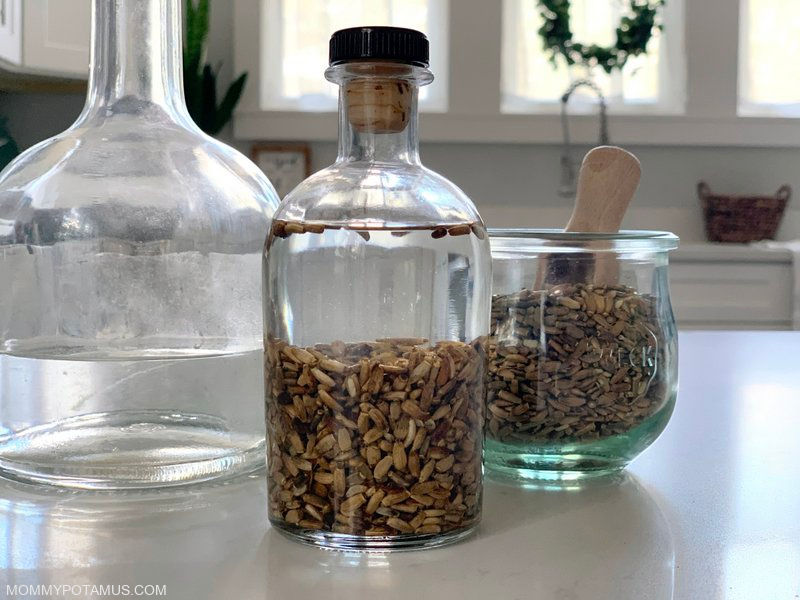
Tincture
Alcohol is much better at extracting silymarin than water, so for milk thistle a tincture is preferred over tea.
Thomas Easley and Steven Horne, authors of The Modern Herbal Dispensatory, recommend 3-8 ml (about 1/2 to 1 1/2 teaspoons) of 1:3 tincture in 70% alcohol (that’s the ratio of seeds to liquid + the alcohol concentration) up to four times daily.
You can find a 1:3 tincture here or follow the recipe below to make your own.
How To Make Milk Thistle Tincture ^
Ingredients
- 2 oz. milk thistle seeds (by weight)
- 6 oz. 6 ounces of 100 proof alcohol (by volume)
Instructions
- Coarsely grind the milk thistle seeds in a coffee grinder.
- Transfer them to a jar and add the alcohol.
- Place in a dark cabinet and allow the mixture to infuse for six to eight weeks, shaking occasionally.
- Once the tincture is ready, strain out the seeds using a fine mesh sieve or cheesecloth.
- Label the tincture and store it in a cool spot away from direct sunlight.
Does milk thistle have any side effects or precautions? ^
According to the Botanical Safety Handbook, 2nd edition, it’s a Safety Class 1A herb – the safest rating possible. It is described as:
- “Herbs that can be safely consumed when used appropriately.
- History of safe traditional use
- No case reports of significant adverse events with high probability of causality
- No significant adverse events in clinical trials
- No identified concerns for use during pregnancy or lactation
- No innately toxic constituents
- Toxicity associated with excessive use is not a basis for exclusion from this class
- Minor or self-limiting side effects are not bases for exclusion from this class”
With that said, milk thistle may cause allergic reactions in people who are sensitive to plants in the Asteraceae family – for example, ragweed, daisies, marigolds, and chrysanthemums.
Have a question about milk thistle? ^
Please let me know in the comments below?
Want more research-backed natural remedies? ^
No problem, I’ve created a free ebook for you – Kitchen Apothecary: 25+ Natural Remedies Using Ingredients From Your Pantry – as a gift for signing up for my newsletter. You’ll also get updates when I post about safe essential oils for pregnant/breastfeeding mamas, exclusive gifts and coupons (I was able to give away a jar of free coconut oil to anyone who wanted it recently!), plus other goodies.
Sign up using the form below.
1. Ludovico Abenavoli & Stefano Bellentani (2014) Milk thistle to treat non-alcoholic fatty liver disease: dream or reality?
2. Swift, Katja and Midura, Ryn (2018) Herbal Medicine for Beginners: Your Guide to Healing Common Ailments with 35 Medicinal Herbs
3. Columbia Surgery Center for Liver Disease and Transplantation. The Liver and Its Functions
4. Hoffman, David (2003) Medical Herbalism: The Science Principles and Practices Of Herbal Medicine
5. Mamalis, Andrew et. al. (2013) The active natural anti-oxidant properties of chamomile, milk thistle, and halophilic bacterial components in human skin in vitro
6. Vargas-Mendoza, Nancy et. al. (2020) Flavolignans from Silymarin as Nrf2 Bioactivators and Their Therapeutic Applications
7. Thomas Easley and Steven Horne (2016) The Modern Herbal Dispensatory
8. Di Pierro, Francesco et. al. (2008) Clinical efficacy, safety and tolerability of BIO-C (micronized Silymarin) as a galactagogue
9. Harvard Medical School (2019) How it’s made: Cholesterol production in your body
10. Huseini, H Fallah et. al. (2006) The efficacy of Silybum marianum (L.) Gaertn. (silymarin) in the treatment of type II diabetes: a randomized, double-blind, placebo-controlled, clinical trial
11. Virginia Tyler and Steven Foster (1999) Tyler’s Honest Herbal: A Sensible Guide to the Use of Herbs and Related Remedies (4th Edition)

